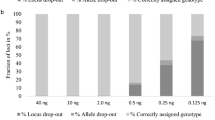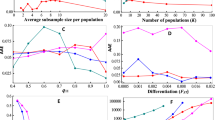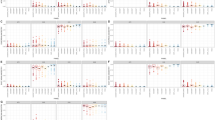Abstract
Microsatellite markers are an essential tool for genetic linkage analysis because of their high polymorphism content. Four hundred commercially available markers covering the entire genome were genotyped from 578 sib individuals from 249 Korean families. Allelic frequencies and heterozygosities were determined for each marker loci and compared between Korean, Taiwanese, Japanese and Caucasian populations. In the three Asian populations, 10–13% of the markers had less than 0.6 heterozygosity, whereas in the Caucasian population, only 0.5% of the markers had less than 0.6 heterozygosity. Mean identical by descent (IBD) values were calculated for 578 sib individuals.Analysis of IBD values greater than 0.5 suggested that markers with low heterozygosity can also provide positive linkages, at least for the IBD sharing method of model-free linkage analysis. The data presented in this study will be a useful reference for genome-wide screens of Koreans and comparative studies with other ethnic populations.
Similar content being viewed by others
Log in or create a free account to read this content
Gain free access to this article, as well as selected content from this journal and more on nature.com
or
References
Bowcock AM, Ruiz-Linares A, Tomfohrde J, Minch E, Kidd JR, Cavalli-Sforza LL (1994) High resolution of human evolutionary trees with polymorphic microsatellites. Nature 368:455–457
Elston RC (1992) Segregation and linkage analysis. Anim Genet 23:59–62
Ikari K, Onda H, Furushima K, Maeda S, Harata S, Takeda J (2001) Establishment of an optimized set of 406 microsatellite markers covering the whole genome for the Japanese population. J Hum Genet 46:207–210
Lu CH, Lin CG, Huang L, Wang LM, Wu LS (2004) Heterozygosities and allelic frequencies of 811 dinucleotide-repeat marker loci in the Taiwanese population. J Hum Genet 49:325–333
Mizutani M, Yamamoto T, Torii K, Kawase H, Yoshimoto T, Uchihi R, Tanaka M, Tamaki K, Katsumata Y (2001) Analysis of 168 short tandem repeat loci in the Japanese population, using a screening set for human genetic mapping. J Hum Genet 46:448–455
Ott J, Rabinowitz D (1997) The effect of marker heterozygosity on the power to detect linkage disequilibrium. Genetics 147:927–930
Schellenberg GD, Bird TD, Wijsman EM, Orr HT, Anderson L, Nemens E, White JA, Bonnycastle L, Weber JL, Alonso ME et al (1992) Genetic linkage evidence for a familial Alzheimer’s disease locus on chromosome 14. Science 258:668–671
Tan EC, Wu H, Yong R, Tan S, Chang J, Gan L, Yap E (2002) Heterozygosities and allelic frequencies of a set of microsatellite markers used for genome-wide scans in a Chinese population. J Hum Genet 47:623–631
Thomson JA, Pilotti V, Stevens P, Ayres KL, Debenham PG (1999) Validation of short tandem repeat analysis for the investigation of cases of disputed paternity. Forensic Sci Int 100:1–16
Yamane-Tanaka Y, Kogawa K, Tanaka T, Nakamura Y, Isomura M (1998) Heterozygosities and allelic frequencies of 358 dinucleotide-repeat marker loci in the Japanese population. J Hum Genet 43:165–168
Acknowledgments
This work was supported by intramural grants from the Korea National Institute of Health, Korea Center for Disease Control, Republic of Korea (project no.: 347-6111-211), a grant from the Korea Health 21 R&D Project, Ministry of Health & Welfare, Republic of Korea (00-PJ3-PG6-GN07-001), and a grant from Ministry of Health and Welfare, Republic of Korea (A000385) to Y.S. Jang.
Author information
Authors and Affiliations
Corresponding author
Rights and permissions
About this article
Cite this article
Park, MH., Kim, KS., Lee, HJ. et al. Allelic frequencies and heterozygosities of microsatellite markers covering the whole genome in the Korean. J Hum Genet 53, 254–266 (2008). https://doi.org/10.1007/s10038-008-0247-5
Received:
Accepted:
Published:
Issue date:
DOI: https://doi.org/10.1007/s10038-008-0247-5



